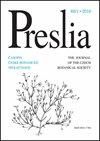Formalized classification of the class Montio-Cardaminetea in Europe
IF 2.9
2区 生物学
Q1 PLANT SCIENCES
引用次数: 0
Abstract
The class Montio-Cardaminetea includes vegetation of springs with constant water flow. These habitats, which function as islands for highly specialized and sensitive biota, are endangered by ongoing landscape and climatic changes. Although a harmonized classification into vegetation units is necessary for effective habitat conservation, there is currently no synthetic classification of the class Montio-Cardaminetea. Here a large set of vegetation-plot records was obtained from national and private databases. The aim was to validate the EuroVegChecklist classification scheme, search for additional ecologically meaningful vegetation types and develop an automatic system for classifying new plots from Europe. We formally defined the cores of eight of the ten EuroVegChecklist alliances: Caricion remotae, Cratoneurion commutati, Lycopodo europaei-Cratoneurion commutati, Epilobio nutantis-Montion, KoenigioMicrojuncion, Mniobryo-Epilobion hornemanii, Philonotidion seriatae (Cardamino-Montion) and Swertio perennis-Anisothecion squarrosi, which were also reproduced by unsupervised classifications. Both unsupervised and semi-supervised classifications further suggested two alliances not previously recognized in the EuroVegChecklist: Anthelion julaceae (liverwortdominated subalpine to alpine springs in highly oceanic regions in Britain) and Cratoneuro filicini-Calthion laetae (mesotrophic herb-rich subalpine and alpine springs). The unsupervised classifications mainly reflected the base saturation gradient, distinguishing between calcareous and non-calcareous springs. Therefore, it is suggested the order Montio-Cardaminetalia, which is broadly delimited in the EuroVegChecklist, be divided into two separate orders and the following three orders should be distinguished within the class Montio-Cardaminetea: CardaminoChrysosplenietalia (non-calcareous forest springs; Caricion remotae), Cardamino-Cratoneuretalia (calcareous springs; Cratoneurion commutati, Lycopodo europaei-Cratoneurion commutati) and Montio-Cardaminetalia (non-calcareous non-forest springs; all other alliances).欧洲Montio-Cardaminetea类的正式分类
本文章由计算机程序翻译,如有差异,请以英文原文为准。
求助全文
约1分钟内获得全文
求助全文
来源期刊

Preslia
生物-植物科学
CiteScore
5.20
自引率
29.40%
发文量
8
审稿时长
>12 weeks
期刊介绍:
Preslia is a peer-reviewed scientific journal publishing original research papers on plant systematics, morphology, phytogeography, ecology and vegetation science, with a geographical focus on central Europe. The journal was founded in 1914 and named in honour of brothers Jan Svatopluk Presl (1791–1849) and Karel Bořivoj Presl (1794–1852), outstanding Bohemian botanists. It is published quarterly by the Czech Botanical Society.
 求助内容:
求助内容: 应助结果提醒方式:
应助结果提醒方式:


